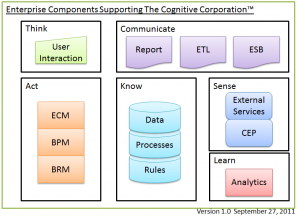The Cognitive Corporation™ – An Introduction
Given my role as an enterprise architect, I’ve had the opportunity to work with many different business leaders, each focused on leveraging IT to drive improved efficiencies, lower costs, increase quality, and broaden market share throughout their businesses. The improvements might involve any subset of data, processes, business rules, infrastructure, software, hardware, etc. A common thread is that each project seeks to make the corporation smarter through the use of information technology.
As I’ve placed these separate projects into a common context of my own, I’ve concluded that the long term goal of leveraging information technology must be for it to support cognitive processes. I don’t mean that the computers will think for us, rather that IT solutions must work together to allow a business to learn, corporately.
The individual tools that we utilize each play a part. However, we tend to utilize them in a manner that focuses on isolated and directed operation rather than incorporating them into an overall learning loop. In other words, we install tools that we direct without asking them to help us find better directions to give.
Let me start with a definition: similar to thinking beings, a cognitive corporation™ leverages a feedback loop of information and experiences to inform future processes and rules. Fundamentally, learning is a process and it involves taking known facts and experiences and combining them to create new hypothesis which are tested in order to derive new facts, processes and rules. Unfortunately, we don’t often leverage our enterprise applications in this way.
We have many tools available to us in the enterprise IT realm. These include database management systems, business process management environments, rule engines, reporting tools, content management applications, data analytics tools, complex event processing environments, enterprise service buses, and ETL tools. Individually, these components are used to solve specific, predefined issues with the operation of a business. However, this is not an optimal way to leverage them.
If we consider that these tools mimic aspects of an intelligent being, then we need to leverage them in a fashion that manifests the cognitive capability in preference to simply deploying a point-solution. This involves thinking about the tools somewhat differently.
As I consider the vision of empowering a learning corporation, I break enterprise tools into 6 general areas. These areas provide a portion of what is required in order to survive and grow in an environment. These 6 areas are: Think, Communicate, Act, Know, Sense and Learn. They are in no particular order since the absence of any will prevent meaningful growth from occurring.
I’ll be expanding on this concept over time, drilling into each area and the solutions we often use to meet that need. Depicted below is a very high-level diagram of these areas with the categories of products or functions I place in each. The categories are broad and I’ve chosen key terms to represent a lot of different tools and techniques.
This framework provides an infrastructure, similar to how a person is made up of a set of systems. However, it is the information that is shared between systems that becomes the key to actually supporting the idea of a thinking and learning system. There are assumptions we make as we design enterprise systems that will limit our ability to empower a cognitive corporation™.
For instance, we may limit our definition of valuable data to the information collected by our on-line systems. A broader interpretation begins to consider the process steps followed and the rules executed for a given interaction as data. There are many places where such assumptions and limitations will interfere with gaining a true advantage from our enterprise solutions.
We must change our view of the way that a business benefits through the use of IT. The focus on feature sets for a specific type of problem must be replaced with a focus on the whole set of systems and how they interrelate and may be leveraged to benefit business growth – in multiple dimensions. This will allow us to make an order-of-magnitude jump in the value derived from IT investments.
Therefore, an enterprise architecture goes beyond the role that systems will play, it must define how the systems will interact within the entire enterprise. We are then in a position to leverage these powerful tools to create a cognitive corporation™.
Tags: BPM, cognitive corporation, enterprise applications, enterprise systems, Information Systems, linkedin, system integration
